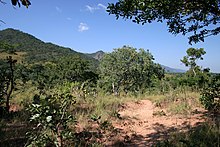Miombo

Miombo is a vast forest savanna type ( dry forest ) with little undergrowth in south-central Africa, whereby the term is also used beyond these borders. The term Miombo comes from the predominant wood species Brachystegia boehmii and Brachystegia longifolia , which are called Muombo (plural: Miombo) in some regional languages.
Distribution area
Miombo can be found in Zimbabwe , Zambia , Mozambique , Angola , Tanzania , Malawi and Botswana . With around 5 million square kilometers in the whole of Africa, the Miombowald forms the largest dry forest area on earth.
Characteristic
The Miombo is characterized by the three typical plant genera Brachystegia with 21 species, Isoberlinia with 3 species and Julbernardia with 2 species. They have pinnate leaves and a characteristic umbrella shape. The trees form a loose forest, the ground of which is only sparsely covered by grasses and bushes. Miombo develops mainly on nutrient-poor, acidic and geologically-pedologically old soils ( Ultisole , Alfisole , Oxisole , Vertisole , Entisole ). The dependence on precipitation is relatively low: Miombo forest can hold itself in dry savannas with about 650 to 1000 mm annual precipitation, but also in wet savannas with up to 1500 mm rain. However, the rains in this region are not distributed over the year; there is a pronounced dry season from May to November. Due to the drought, the plants are temporarily exposed to extreme stress, which can be intensified by the ingress of cold air with frosts.
Human influence
Fires often occur in the dry season. While some fires are caused by lightning, the real driving force is humans. The clearing of Miombo forest can be traced back to around 3000 years ago, so that an equally natural stage has now settled in Miombo. Today the open Miombo forest even needs the frequent fires. They repeatedly destroy part of the trees, which means that other plants such as grasses and bushes can also develop in the miombo.
Increasing overexploitation by tobacco
The film incense of Peter Heller and the campaign "smoke signals" and the first business ethically and environmentally economically motivated study of the World Health Organization (2017) to the human-ecological overall effects of tobacco smoking , composed of German geographer Helmut mind document the consequences of tobacco growing in the Miombowaldzone Africa. For example, the Miombo dry forest in Tanzania is being cleared excessively in order to plant tobacco and to gain wood in order to dry up ( curing ) green tobacco plants . The ovens used for this are fired inefficiently: from an early phase of tobacco cultivation in the Tabora region, it is reported that an average of 150 tons of wood was used to dry one ton of tobacco. Contemporary satellite images from Malawi show that between the 1970s and 1991 around 44 percent of the tree population in the Malawian region of Namwera was destroyed. But the Virginia -Tabakbauern that only three percent account for all farmers in Malawi, the entire clearcuts are responsible for 80 percent.
Individual evidence
- ^ Paul Smith, Quentin Allen: Field Guide to the Trees and Shrubs of the Miombo Woodlands. Royal Botanic Gardens, Kew 2004.
- ↑ filmkraft filmproduktion: Rauchopfer - The deadly strategies of the tobacco multinationals . Retrieved April 24, 2017 .
- ↑ Smoke signals!
- ^ WHO: Tobacco and its environmental impact. WHO, Geneva 2017, p. Ix, accessed July 30, 2017.
- ↑ H. Geist: Transforming the fringe - Tobacco-related wood usage and its environmental implications. In: R. Majoral, H. Jussila, F. Delgado-Cravidão (Eds.): Environment and Marginality in Geographical Space - Issues of land use, territorial marginalization and development in the new millennium. Ashgate, Aldershot 2000, pp. 87-118.
- ↑ H. Geist: The mountainous country of Namwera - A case study on land degradation, common division and brown gold. In: GAIA: Ecological perspectives in the natural sciences, humanities and economics. 7 (4), 1998, pp. 255-264.
- ↑ H. Geist: Tropical forest destruction by tobacco - A thesis discussed using the example of African Miombo forests. In: Geographical Rundschau. 50 (5), 1998, pp. 283-290.